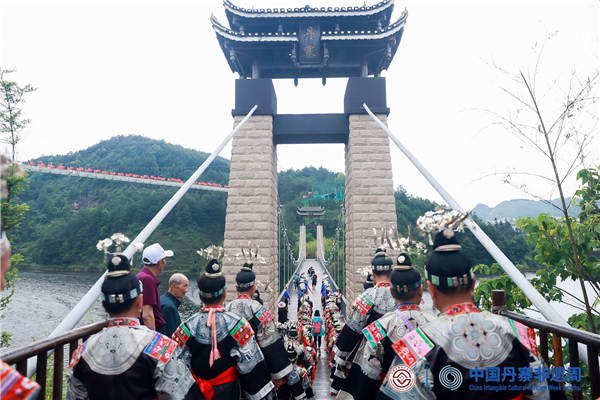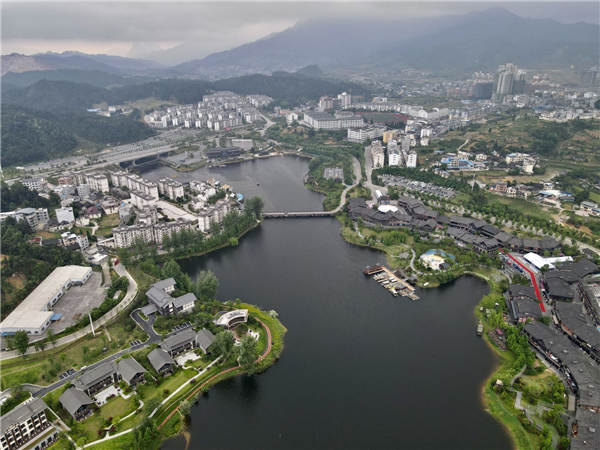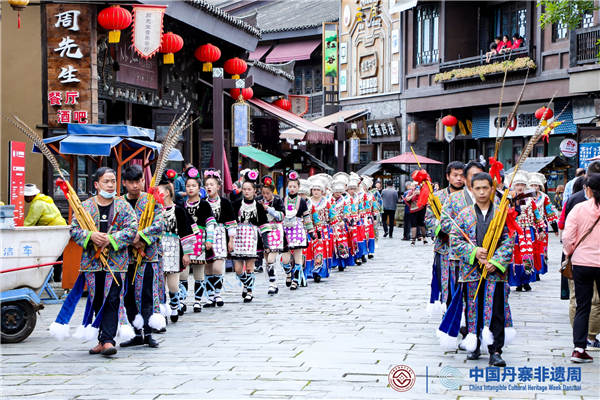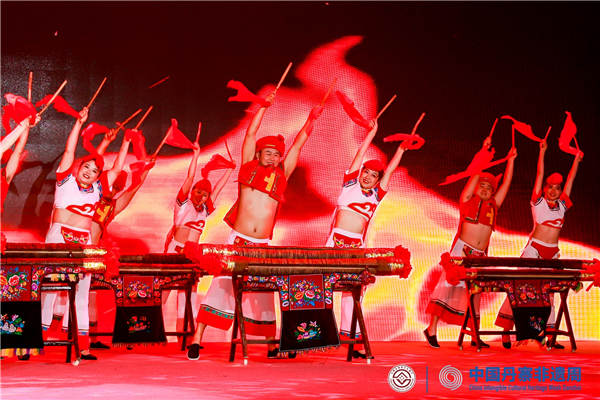
The Guizhou Statistics Bureau says that in the period 2016-2020 Guizhou Qiandongnan prefecture received 483 million tourist visits and tourism income of 420 billion yuan. [Photo provided to China Daily]
Cultural experts discuss way of ensuring that heritage remains relevant and survives.
Protecting intangible cultural heritage means maintaining cultural diversity, the foundation of cultural tourism, says Lyu Pintian, a researcher at the Chinese Academy of Arts.
"The key to complementing protection and utilization is not to turn intangible heritage into tourist performances," he says. "The essence of intangible heritage is the daily life of those who live in tourist destinations."
Lyu was speaking during the second China Danzhai Intangible Heritage Week in Danzhai, Guizhou province, which began on May 15 and finishes on Sunday.
At one of the events, the China Intangible Heritage and Tourism Integration Development Forum on May 15, Dai Bin, dean of the China Tourism Research Institute, asked: "Can the ancient and rich intangible cultural heritage become more fashionable? Can it take the route of light luxury, and can it promote the integration of culture and tourism to go further?"
Intangible cultural heritage should return to its roots in contemporary life and rebuild its purpose and value in daily life, he said.
"Of course intangible heritage needs to be protected and inherited. When it has contemporary value, there is no doubt that it will perpetuate itself and expand. The role of the market in protecting and making the most of intangible cultural heritage should be accorded its original place. We must trust in the cultural tastes of people and in the commercial wisdom of business people."
Zou Tongyan, dean of the School of Tourism Management of Beijing International Studies University, said that if intangible cultural heritage cannot be endowed with new forms, new scenes, new meanings and new contexts it risks becoming extinct.

With the help of its rich intangible cultural heritage assets, Danzhai has emerged as a tourist attraction. In just four years Danzhai Wanda Town has received more than 20 million tourists and according to official figures by May 12 the number of visitors to Danzhai had risen by 3 percent year-on-year compared with 2019. [Photo provided to China Daily]
"It must be integrated into current life. One of the biggest problems is a lack of professional tourism planners in activating authentic intangible heritage tourism. In addition, the scale of such heritage projects is relatively small, and with low economic return we have yet to witness the scale effect."
Accurately positioning the development of intangible heritage and tourism for rural revitalization has been a major theme of the heritage week.
One event during the week, an exhibition titled "Intangible Cultural Heritage Helping Precision Poverty Alleviation", guided by the Intangible Heritage Department of the Ministry of Culture and Tourism, showcased intangible cultural heritage poverty alleviation employment workshops across the country. Sixty workshops were selected from 16 counties and cities in Qiandongnan prefecture, covering activities such as Miao embroidery, Dong embroidery, Miao silver ornaments, Miao batik, bamboo weaving, rattan weaving, inkstone, ethnic medicine, tea and specialty snacks.
More than 30 traditional craft intangible cultural and creative projects, and nearly 20,000 intangible cultural and creative products have been displayed and sold at the event site.
Lin Jifu, a professor at Minzu University of China in Beijing, said rural revitalization is a "comprehensive revitalization" centered on the wholeness and relevance of rural people's lives. As an excellent rural traditional culture, intangible cultural heritage has become an important part of this revitalization. It is necessary to realize the mutual integration of rural revitalization and the construction of cultural and ecological protection areas.

Danzhai county has created an all-element intangible cultural heritage environment seeping into all elements of tourism. [Photo provided to China Daily]
"The key for the connection is space empowerment," Lin said. "Danzhai belongs to the core area of the Qiandongnan National Cultural Ecological Protection Experimental Zone. Danzhai Wanda Town is a very important space for rural revitalization and poverty alleviation."
"Culture is a unique symbol of a nation, and cultural heritage is its long-term memory," said Luo Qiang, deputy secretary of the Qiandongnan Prefecture Party Committee of Guizhou province and governor of the prefecture. Six more projects in the prefecture have been included in the fifth batch of national intangible cultural heritage list this year. The number of such projects in the prefecture is expected to rise from 56 to 78 in a few years. There is vigorous support for inheritors, and all the heritage projects throughout the prefecture are living skills and cultures still employed by the masses in their current production and life, Luo said.
Lyu Pintian, a researcher, concurs in so far as revitalizing local art is concerned. The roots of Chinese culture lie in the countryside, and the integration of intangible cultural heritage and tourism should be practiced with rural revitalization through the construction of rural art, he said.
"The revitalization of handicrafts and the activation of folk customs are the fundamental path to protect intangible cultural heritage and promote the integrated development of cultural and tourism."
Lan Jing, director of the Ethnic and Folk Literature Development Center of the Ministry of Culture and Tourism, in Danzhai for the first time, said he is deeply impressed by the small town. In his time in the town he has seen a lot of intangible cultural heritage products on the street with unique characteristics of the local Miao and Dong culture.

With the help of its rich intangible cultural heritage assets, Danzhai has emerged as a tourist attraction. In just four years Danzhai Wanda Town has received more than 20 million tourists and according to official figures by May 12 the number of visitors to Danzhai had risen by 3 percent year-on-year compared with 2019. [Photo provided to China Daily]
Qiu Chunlin, director of the Arts and Crafts Research Institute of the China National Academy of Arts, agreed that the development and utilization of intangible cultural heritage products and cultural differences in handicrafts should be based on some of the core elements of local intangible cultural heritage.
Cai Hong, a professor at the Capital University of Economics and Business in Beijing, said the charismatic little town of Danzha reflected to a certain extent that the integrated development of intangible cultural heritage and tourism is a great help in promoting rural revitalization.
An "ethnic medicine and famous doctor free consultation event" during the heritage week, hosted by the Chinese Medicine Coordinating Committee of the China Intangible Cultural Heritage Protection Association, also attracted much interest.
The committee invited representatives of well-known doctors from all over the country to allow tourists to take part in intangible cultural heritage projects of Chinese medicine. The appointment of the free clinic was fully booked within half a day on May 13.

With the help of its rich intangible cultural heritage assets, Danzhai has emerged as a tourist attraction. In just four years Danzhai Wanda Town has received more than 20 million tourists and according to official figures by May 12 the number of visitors to Danzhai had risen by 3 percent year-on-year compared with 2019. [Photo provided to China Daily]
Among the 55 ethnic minorities in China, more than 30 ethnic groups have their own traditional medicines. Traditional Chinese medicine, including ethnic medicines, is an important representative of outstanding traditional culture and has a unique role in protecting China's intangible cultural heritage, said Wang Xiaofeng, president of the China Intangible Heritage Protection Association, at the first Ethnic Medical Intangible Cultural Heritage Forum in Danzhai on May 16. Exploring the protection and inheritance of traditional ethnic medicine has become a new highlight of China's heritage work.
TCM acupuncture and Tibetan medicine prevention have been included in the UNESCO Representative List of Human Intangible Cultural Heritage. Among the four batches, 10 categories and 1,372 national intangible cultural heritage items that have been published on the representative list of national intangible cultural heritage, 137 traditional medicine items account for 9.99 percent, with 132 national representative inheritors.
Sun Da, deputy director of the State Administration of Traditional Chinese Medicine, said that to help build a healthy community it will continue to support ethnic minority medicines.
"Traditional Chinese medicine has become an important part of cultural exchanges between China and the rest of the world and in promoting exchanges between Eastern and Western civilizations."

